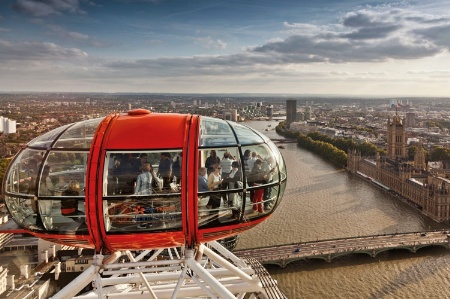Source: Getty
From its soaring property prices and City bonus culture to its multi-ethnic population and thriving cultural scene, London, in many ways, stands apart from the rest of the UK.
But is the same now true of the capital’s higher education system? Might Europe’s largest metropolis – whose population is growing twice as fast as in the rest of Britain – be considered as a university system in its own right, as different from the rest of England as Scotland, Wales and Northern Ireland?
Many facets – such as its student body, income source and inward investment – suggest that it is distinct. And with London universities performing far better on some metrics than those outside the M25, some believe that the city is starting to dominate.
But being in the capital also brings specific challenges. Writing in Times Higher Education earlier this year, Malcolm Gillies, vice-chancellor of London Metropolitan University and chair of London Higher, the body representing the city’s universities, argued that “for a large number of universities in the capital, London is a highly defining feature. London is their biggest headache – estate, business, infrastructure, staffing costs – and also their biggest opportunity.”
The city is “different from the rest of the UK, and becoming more different”, he wrote, before asking: “Frankly, does London need the rest of the UK?”
Here, we look at some of the key trends and features that define London’s higher education landscape.
Lure of the big city
Charles Clarke, the former Labour education secretary, once argued that there were too many universities in London. When he was in office, he considered forcing some to merge.
More than 40 higher education institutions are based in the capital, but that has not deterred others from setting up outposts in the city in recent years. A dozen universities based elsewhere in the UK – Abertay, Anglia Ruskin, Bangor, Coventry, Cumbria, East Anglia, Glasgow Caledonian, Glyndwr, Liverpool, Sunderland, Ulster and the University of Wales Trinity Saint David – have established campuses in London, with more planning to follow.
Overseas universities are a growing presence in London, too. American institutions range from long-standing, fully fledged campuses (such as the Delaware-registered Richmond, The American International University in London) to business schools (such as the University of Chicago Booth School of Business) and small study centres (New York University, Florida State University, University of Notre Dame and Syracuse University).
Meanwhile, Malaysia’s Limkokwing University opened in Piccadilly in 2007 and India’s non-profit Amity University, the country’s first private university, known for its high-profile sponsorship in Indian Premier League cricket, set up in Bedford Square in 2009.
Northumbria University and the University of South Wales will become the latest to open new campuses in the capital later this year, while Warwick Business School will have a base on the 17th floor of the Shard, the tallest building in the European Union, from 2015.
“We have been seen as a Wales-only or South Wales-only institution, but we want to become more of a national player – London is part of that,” says Huw Williams, deputy vice-chancellor at South Wales.
Some might wonder, however, if the potential fee income from such ventures is worth the time, money and managerial attention that might otherwise be spent on marketing regional universities as student destinations. And could this be seen as another example, as business secretary Vince Cable memorably put it, of London “draining the life out of the rest of the country”?

Unsurprisingly, Williams disagrees with this negative view. As well as attracting students who might not come to South Wales, such as London professionals seeking to upgrade their IT or accountancy skills, the campus will broaden the appeal of South Wales’ main operation by raising the institution’s profile, he argues.
Student mobility will be two way, he adds. “We want students in South Wales to have some experience of London, while London students might also decide to experience South Wales.”
Loughborough University, which will open a campus on the Queen Elizabeth Olympic Park in East London in 2015, insists that the enterprise is far more than just a chance to recruit international students.
“It had to be more than a corridor in a building, which is what some university branch campuses are a bit like,” says Robert Allison, the university’s vice-chancellor.
Instead, the campus, based in the former Olympic press and broadcast centres, will be a substantial academic locus, where academic staff teach, research and collaborate with nearby industries. “Being on the Olympic Park really chimed with our DNA as an institution,” he adds, referring to the university’s reputation for strength in sport.
Allison says the base will allow the university to expand its offer in ways that would not be possible in the East Midlands. “There is something about London that is unlike anything in the UK – it is one of the top five world cities that just happens to be in the UK.
“Some students do want the campus experience we have in Loughborough, but the Olympic Park has small and medium-sized enterprises, business incubators and other organisations clustered on our campus that might not be possible anywhere else.”
According to Mike Caine, dean of the university’s London campus, establishing a London base has reinforced the institution’s traditional strengths and bolstered its research partnerships with industry.
“We have 20 sport associations whose national performance centres are with us [in Loughborough], but many also use London facilities,” he explains. “British Swimming [the national governing body for water sports] has just renewed its commitment to us and we would not have been able to do that without a base at the Olympic Park.”
And whereas some UK universities have followed a strategy of opening campuses abroad, Caine points out that a London base is much more convenient. “It’s very different to having an overseas campus. Instead of being isolated, distant and siloed, it is very accessible to Loughborough students as it is only about an hour and a half away.”
Research funding hub
Will the £650 million Francis Crick Institute, expected to open in King’s Cross next year, confirm London’s status as the UK’s undisputed life sciences capital?
London is already streets ahead of other regions in terms of research funding. It will receive about a third of the £1.5 billion recurrent research funding awarded to universities next year – almost twice as much as the South East and three times that distributed in the North West, according to figures from the Higher Education Funding Council for England.
The sums of money flowing into London from the UK’s two largest research councils – the Engineering and Physical Sciences Research Council and the Medical Research Council (£167 million and £121 million in 2012-13, respectively) – also dwarf those paid out in other regions, with only Scotland coming close (£100 million and £50 million, respectively).

But some believe that the long-awaited Crick Institute, which will be Europe’s largest biomedical laboratory, employing 1,500 staff and with an annual budget of more than £100 million, will help London to move away from the chasing pack, pulling in enormous sums from venture capitalists, medical charities, research councils and its three university backers – King’s College London, University College London and Imperial College London.
If industrial research funding becomes further concentrated in the capital, this would match trends seen elsewhere in the world, says Ben Rogers, director of the thinktank Centre for London. “It used to be that big tech firms would set up along the A4 [west of the capital], but now they want to be part of the action in London,” he explains.
This global shift towards capital cities has been described as the decline of “Nerdistan” – regional, often purpose-built towns populated by high-tech workers. “Even Silicon Valley may soon suffer from this phenomenon as companies move to high-density urban areas,” Rogers claims.
Such a drift into cities presents a “huge opportunity” for London’s universities and the metropolis in general, despite worries about the lack of affordable housing and transport issues, he adds.
Danny Dorling, Halford Mackinder professor of human geography at the University of Oxford, explains the draw of London for academics and researchers in different terms.
“London allows couples to sustain two careers,” he says. “If you head off to the University of Warwick, you might have a good job, but your partner might not.”
Onwards and upwards
More young people in London go to university than in any other region.
According to Social Mobility in London: The Role of Higher Education, a report published last year by AccessHE, 48 per cent of young people in London progress to university study, 10 percentage points higher than any other region.
The gulf in university participation rates has also widened over the past 15 years: participation rates in London climbed by a third between 1998 and 2012, a faster rate than in other areas of the UK.
“If you take London out of the equation, the increase in participation doesn’t look nearly as impressive,” remarks Graeme Atherton, director of AccessHE, which organises school outreach for London universities.
Improved exam attainment owing to better schools has played a major part, but the variety of nearby higher education institutions is also important, explains Atherton. “You have all types of provision – campus, specialist, business schools, former polytechnics – as well as lots of part-time provision very close to home.”
London’s multi-ethnic population also helps to explain the leaps in the higher education rate, Atherton says. “You have about 50 different minority communities in London of 40,000 people or more, and some engage very well with higher education – although not all groups do.”
In fact, the evidence suggests that it is immigration status – rather than ethnicity – that explains much of the dramatic improvement in London’s education fortunes, Dorling thinks, with the children of immigrants often strongly motivated to attend university.

“An immigrant might be a taxi driver, but they have enormous hopes for their children and will push them towards higher education,” he explains. “It might not even be a direct instruction, but what children pick up through stories and from the sacrifices their parents make.”
And at the other end of the income spectrum, among the children of wealthy immigrants arriving in London – the scions of Russian oligarchs, Chinese millionaires and well-heeled French professionals – participation is “almost 100 per cent”, he adds.
Another factor is the strength of London’s schools, Dorling says. “If you also consider that the bottom 10 per cent of London schools perform as well as the Norfolk average, then it’s not hard for London universities to recruit poorer students – it would be an indictment if they didn’t,” he claims.
Expensive living
London is surely in a league of its own when it comes to what has been termed the “cost of living crisis”.
“One of our European students found it was actually cheaper to fly in and out on the two or three days a week she had classes than to live in London,” says Denza Gonsalves, president of Kingston University Students’ Union.
“Student accommodation here is about £420 a month, but even the smallest room with a private provider costs £500 a month,” she explains.
Yet rents in Kingston – a leafy suburb in south-west London – are far lower than those charged in the heart of the city. Private student housing provider Nido charges between £249 and £360 a week for rooms in its Spitalfields centre – and up to £470 a week for a studio – for 2014-15.
As well as placing financial pressure on students, high rents drive many to embark on long commutes, Gonsalves says, with 35 per cent of Kingston students using public transport each day.
Many decide to live at home during their studies because those living within 15km of Kingston are unable to apply for first-year accommodation – restrictions that are fairly typical for London universities, she adds.
As a result, “it becomes very difficult to create a sense of community as students come into university only for their lectures – it’s very hard to put on any events outside 9am to 6pm”, Gonsalves explains.
Other universities have also acknowledged the potential fracture between “home” and “halls” students. Queen Mary University of London, for example, has set up buddy schemes and stay-at-home student representation on its students’ union board.
But high rents have done little to deter undergraduates from flocking to the capital. London’s market share of both applications and accepted applicants (17.3 and 15.6 per cent, respectively, in 2013-14) is virtually unchanged from 2010-11 levels, despite the advent of £9,000 tuition fees and the city’s relatively poor performance in the National Student Survey. (Fifteen of the 34 bottom-ranked higher education institutions in last year’s survey were based in London.)
“London is a great place for students in every aspect except cost of living,” argues Rogers, from Centre for London. “It has always been enormously attractive to young people.” According to figures from the Office for National Statistics, the median age in London is 34, compared with 43 in the South West. “We’re now also starting to see people leave London to have children at a later age than they did 15 or 20 years ago,” Rogers adds.

Cultural diversity
London’s appeal to international students also sets it apart. More than a quarter (26 per cent) of students in the capital – 101,000 in total – were international in 2012-13, a figure that drops to 13 per cent in the North West and 15 per cent in the South West, according to the UK Council for International Student Affairs. This compares with 18 per cent nationally.
Robert Jones, strategist at branding consultancy Wolff Olins, which created the famous jagged-edge logo for the London 2012 Olympic Games, believes London universities owe much of their success in recruiting overseas students to the capital’s increasingly powerful international brand. Jones, a visiting professor at the University of East Anglia, said London’s brand is “an amazing combination of the traditional and the contemporary”.
“Ten years ago, London was known for its heritage – Big Ben, the Tower of London – but now it’s equally known for being modern, with buildings such as Tate Modern, the Shard and the Gherkin,” Jones says.
“The games definitely contributed to the sense that London is now a young and exciting place, countering the old perception that the London brand is just about tradition,” he adds.
But because of their high proportion of international students, London institutions are likely to be hardest hit financially by the tightening of government immigration policy.
For instance, non-EU fees accounted for 35 per cent of the University of London’s total income in 2012-13 compared with a sector average of 12 per cent. At the London School of Economics the figure was 31 per cent, at City University London 30 per cent and at Soas, University of London 25 per cent.
“The changes to student visas are not London-only issues, but they have a particular edge or relevance in a London context because of the profile of higher education in London,” believes Jane Glanville, chief executive of London Higher.
London also has a high proportion of ethnic minority students, representing 46 per cent of all home students, compared with 15 per cent of students nationally, and reflecting London’s ethnically diverse population. This means that London’s student body is unlike that in any other region, Glanville says.
In terms of its student body and institutional mix, “higher education in London reflects the fact that London is a capital city, a world city and centre for business and an internationally celebrated centre for culture and creativity”, she says. “There are few cities or city regions anywhere in the world – and none in the UK – that can rival London’s marvellously diverse higher education group.”
- 46% of UK students in London are from ethnic minorities, compared with 15 per cent nationally
- 6 - The number of London universities in the top 100 of Times Higher Education’s World Reputation Rankings
- 48% of young Londoners go to university by the age of 19, compared with 35 per cent in the North East
- £470 - The weekly cost of a studio flat in Nido’s Spitalfields student housing accommodation





